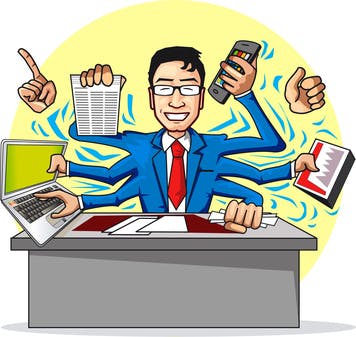Editor’s Note: Sometimes, readers ask about past TLNT articles they may have missed. That’s why on Fridays we republish a Classic TLNT post some of you have asked about.
I used to believe I could multitask.
While I was working, I’d have 10 different websites up while listening to sports talk radio and chatting online. I thought I was doing great until I started missing deadlines, meetings, and forgetting where I was going (even what website I had meant to look up 10 seconds ago).
It was pretty embarrassing, especially when trying to explain exactly why I had missed a meeting clearly on my schedule and missed a deadline that was in front of my face. Over the course of my time in HR, I watched other employees get hit by that same bug.
Part of it is with encouragement from employers though. Expecting your employees to frequently switch between tasks or creating an environment that encourages constant interruption is problematic and here’s why.
Gen Y and multitasking
I made the same mistake that many of my fellow Generation Y’ers make: thinking multitasking can work at work. It doesn’t.
And many people who talk about generational differences love to talk about how Generation Y can multitask better than anyone. If better simply meant being able to juggle the most tasks, then fine. But mega-multitaskers often think they can better handle multiple tasks at once and everything (and I really mean everything) suggests that they can’t.
A BBC story put it pretty succinctly that multitaskers are bad at multitasking. They say:
After, for example, a series of “number” tasks, the experimenters switched to “letter” tasks. Again, low multitaskers significantly outperformed their counterparts in switching to the new task.
“The shocking discovery of this research is that [high multitaskers] are lousy at everything that’s necessary for multitasking,” Professor Nass said.
“The irony here is that when you ask the low multitaskers, they all think they’re much worse at multitasking and the high multitaskers think they’re gifted at it.”
The problem doesn’t have as much to do with multitasking in particular but the types of things we choose to do while multitasking, too.
For people like me who grew up with technology, I was used to being on a discussion board, reading sports news, playing a game, texting and chatting online. But none of those things were really critical. At the end of the night, I had consumed a lot of information but I only retained a small amount of it (I might remember a basketball score or a conversation I had with a friend but not all of the rest of the stories, discussions and games I played).
It isn’t so much that you can multitask better in those situations, it just isn’t important whether you do so or not. And while I may be picking on my fellow Millennials a bit, it doesn’t mean that other generations are that much better at it either (yes, almost all of us try to multitask). It just means that we’re all limited.
Technology to the rescue
When you move into more critical tasks (starting in college with papers and reports and moving up), the ability to successfully multitask goes way down. While multitasking works fine for those tasks that require little thought (and little consequence), tasks that require concentration get hurt the most. And as a business, I’m sure you have your fair share of people who really need to think as part of their regular duties.
Maybe somewhat ironically, technology can actually help this issue.
For example, I write most of my posts in an application called WriteRoom. It is like the notepad application most of you have on your computers but it blacks out the rest of your screen so you can have distraction free writing. The beauty of it is that I almost always get through writing an entire post in a single sitting because there is nothing popping up and distracting me or a dozen other potential distractions from other programs.
The other one I use frequently is an iPad. While it may have multitasking, it still pretty much focuses you on doing one thing at a time. That’s how I’m able to scan through hundreds of articles in 30-60 minutes (something that took me half a day when using the computer). I can also scan through my emails and drop 80 percent of them into the archive before I ever get to a computer.
Other office solutions
Of course, if you’re in an open office or even if you have offices that have doors, interruptions and expectations can create an environment where multitasking is encouraged (inadvertently, mostly).
One of the solutions I’ve seen are some interruption free times. This can either be set by the individual employee or company-wide. You basically set aside some time in your calendar (if individual) or you decide to not have any meetings during certain times (as an example 9-12 on Monday, Wednesday and Friday). That gives people a block of time where they can guarantee they can get focused work accomplished.
For those in open offices, you can also set aside time in shared offices and conference rooms for focused time. At one of the places I worked, we had a library room that was strictly no talking, no interruptions where people could escape to get focused time. It was also one of the advantage to allowing people to work from home on occasion (though I know that comes with its own distractions).
In any case, a more focused workplace can help all of this. What sorts of things have you done to help employees focus better while at work?
